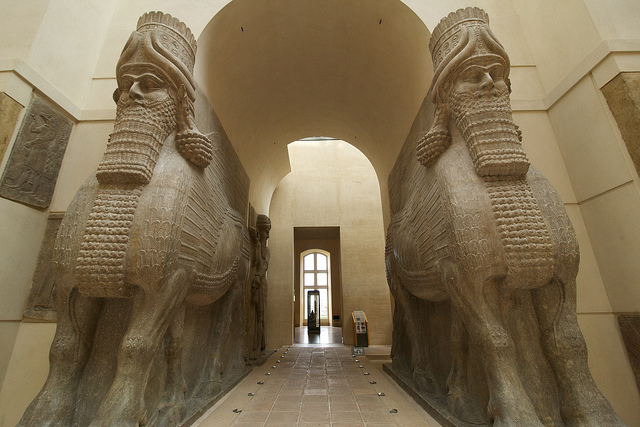 Lamassu (winged bulls) from Khorsabad, restored and housed in the Louvre, Paris, Photo by gulfuroth via Flickr, Creative Commons Attribution-NonCommercial 2.0 Generic License.
Lamassu (winged bulls) from Khorsabad, restored and housed in the Louvre, Paris, Photo by gulfuroth via Flickr, Creative Commons Attribution-NonCommercial 2.0 Generic License.
In recent months, the media has released videotapes of members of ISIS (The Islamic State in Iraq and Syria) destroying irreplaceable artifacts from ancient civilizations with sledgehammers and jackhammers inside the Mosul Museum in Iraq. Thankfully, many of these works of art were moved to other museums for safekeeping in 2003; nevertheless, the militants managed to find some authentic works of art to demolish.
(Fox News reported a few days ago that the terrorists destroyed the copies in order to sell the originals on the black market thus funding their operations, but this is a misinterpretation of the event. The Times of London reported that ISIS has smuggled ancient artifacts into Britain over the last year, but the originals of the copies smashed in the Mosul Museum are not among them.)
ISIS ruined replicas of Roman-era statues from Hatra and managed to destroy eight original statues of Roman kings and noblemen. They also obliterated sculptures of Venus and Nike from the Roman temples. Perhaps most upsetting is the loss of four Assyrian stone lamassu, human-headed winged bulls that were installed in the Nergal Gate at Nineveh during the reign of Sennacherib sometime between 704 and 690 B.C.E. and have remained in their original location since then. These creatures were deities that protected doorways to the palace of the Assyrian kings.
A narrator in one of the videos of the destruction states, “Oh Muslims, the remains that you see behind me are the idols of peoples of previous centuries, which were worshiped instead of Allah. When Allah orders to us destroy these statues, idols and antiquities, we must do it, even if they’re worth billions of dollars.”
The Assyrian period, which endured from c. 2500-605BCE, was a pre-Islamist civilization that represents to ISIS idolatry against the Prophet Muhammad. By destroying the heritage of 19 centuries in the region, the militant Islamist group intends to assert its domination. ISIS has an ideology of cultural and religious purity that relies upon genocide in order to succeed. Likely, this only is the beginning of their destructive enterprise.
 Lamassu (winged bulls) from Khorsabad, restored and housed in the Louvre, Paris, Photo by gulfuroth via Flickr, Creative Commons Attribution-NonCommercial 2.0 Generic License.
Lamassu (winged bulls) from Khorsabad, restored and housed in the Louvre, Paris, Photo by gulfuroth via Flickr, Creative Commons Attribution-NonCommercial 2.0 Generic License.
 Lamassu (winged bulls) from Khorsabad, restored and housed in the Louvre, Paris, Photo by gulfuroth via Flickr, Creative Commons Attribution-NonCommercial 2.0 Generic License.
Lamassu (winged bulls) from Khorsabad, restored and housed in the Louvre, Paris, Photo by gulfuroth via Flickr, Creative Commons Attribution-NonCommercial 2.0 Generic License.

